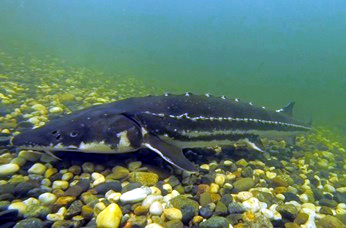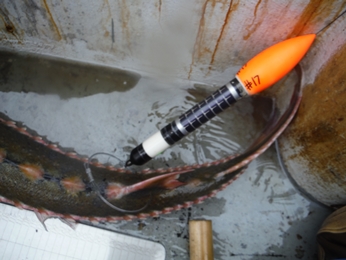Acipenser medirostris
Distribution
 Adult Green Sturgeon. CDFW photo by Mike Healey.
Adult Green Sturgeon. CDFW photo by Mike Healey.
 Satellite tag attached to the tail of a Green Sturgeon, illustrating the sharp, bony scutes. NOAA photo.
Satellite tag attached to the tail of a Green Sturgeon, illustrating the sharp, bony scutes. NOAA photo.
There are two genetically identifiable populations, or Distinct Population Segments (DPS), of Green Sturgeon recognized by the state and federal governments. The northern DPS is known to spawn in the Klamath River in California, as well as the Rogue River in Oregon. Northern DPS fish have also been observed in the Trinity and Eel rivers, as well as in the Umpqua River (OR), though it is not yet clear if they routinely spawn in those locations. Southern DPS Green Sturgeon are found in the Sacramento and San Joaquin rivers and Delta. They primarily spawn in the upper mainstem of the Sacramento River, although some spawning activity has recently been documented in the Feather and Yuba rivers. The extent to which the species uses the San Joaquin River is unclear at this time, although an adult fish was recently found in a major tributary, the Stanislaus River, indicating at least some use of that system. Green Sturgeon are one of the most marine-oriented sturgeon species, spending much of their life in coastal Pacific Ocean waters from Ensenada, Mexico, to the Bering Sea. The species frequently enters large coastal bays and estuaries, including the San Francisco Bay estuary, Columbia River estuary (WA), Willapa Bay (WA) during the summer to feed, with fish from both DPS’s mingling freely in those habitats.
Life History and Ecology
Green Sturgeon spend much of their life in marine waters, more so than most other sturgeon species. Adults and sub-adults spend many months each year in ocean waters along the coasts of CA, OR, and WA. In the summer, these fish often enter bays or brackish estuaries to feed. Age at first reproduction is approximately 15 years old, after the fish have grown to about 150 cm length. Green Sturgeon can live to 60 years old and grow to approximately 256-270 cm, with females growing larger than males. The species is anadromous, migrating in March-June from seawater into the freshwater reaches of larger coastal rivers to spawn. Sturgeon do not die after spawning like Pacific salmon, and the species is capable of repeated migrations every 2-6 years. Green Sturgeon spawn in cool, deep, swift flowing river reaches over gravel and cobble bottoms. Some adults exit the river rapidly after spawning, but many over-summer in deep pools and leave with the onset of winter rain storms. The early life stages of Green Sturgeon are still not well understood and are in need of continued research. Current evidence indicates that dispersed, fertilized eggs settle to the bottom and stick in the spaces between the gravel. Eggs hatch into the larval stage after about 12 days. After the larvae use up their yolk supply, they start feeding on zooplankton before shifting mostly to benthic macroinvertebrates. Juveniles grow rapidly and migrate down-river after about a year, taking up residence in the freshwater region of the estuary. They are able to tolerate saline water at around 30 cm length, although they usually do not enter seawater until they are larger. The sub-adult stage starts when the fish first enter the Pacific Ocean and continues until they reach maturity and are able to reproduce.
Threats
The primary spawning habitats of Green Sturgeon are confined to short reaches of a small number of rivers, so the species is vulnerable to habitat loss and climate change that might degrade or destroy those sites. In particular, most of the reproduction of the sDPS takes place in a small segment of the Sacramento River, which led to the DPS being listed as Threatened under the Federal Endangered Species Act. Temperature has a major impact on Green Sturgeon growth and development and early life stages are very sensitive to temperature, particularly eggs and larvae. These stages grow optimally at around 15°C and exhibiting reduced growth, deformities, or death at temperatures lower than 11°C and higher than 20°C. Other factors that threaten Green Sturgeon include entrainment of early life stages into water diversions, contaminants from pollution and terrestrial runoff, and poaching and illegal fishing.
Conservation and Management
Southern DPS Green Sturgeon are protected as a Threatened species under the Federal Endangered Species Act, so no take of any kind is permitted. Take is defined as “harass, harm, pursue, hunt, shoot, wound, kill, trap, capture, or collect, or to attempt to engage in any such conduct.” CDFW regulations also prohibit take or possession Green Sturgeon anywhere in California, regardless of DPS, with the exception of a small, well-regulated, tribal fishery for northern DPS fish on the Klamath River. In all other cases, fish hooked accidentally may not be removed from the water and must be released unharmed immediately. Green Sturgeon captured accidentally in the White Sturgeon recreational fishery must be released and reported on the Sturgeon Fishing Report Card. All sturgeon fishing is prohibited in the Sacramento River from the Highway 162 bridge to Keswick Dam in order to protect Green Sturgeon at the primary spawning grounds.
Sturgeon Carcass Reporting
Researchers studying the causes of death of adult sturgeon (PDF) request that any observations of sturgeon carcasses be reported to CASturgeonResearch@gmail.com.
For more information, contact CDFW Fisheries Branch, Sturgeon@wildlife.ca.gov.
CDFW
Other Agencies